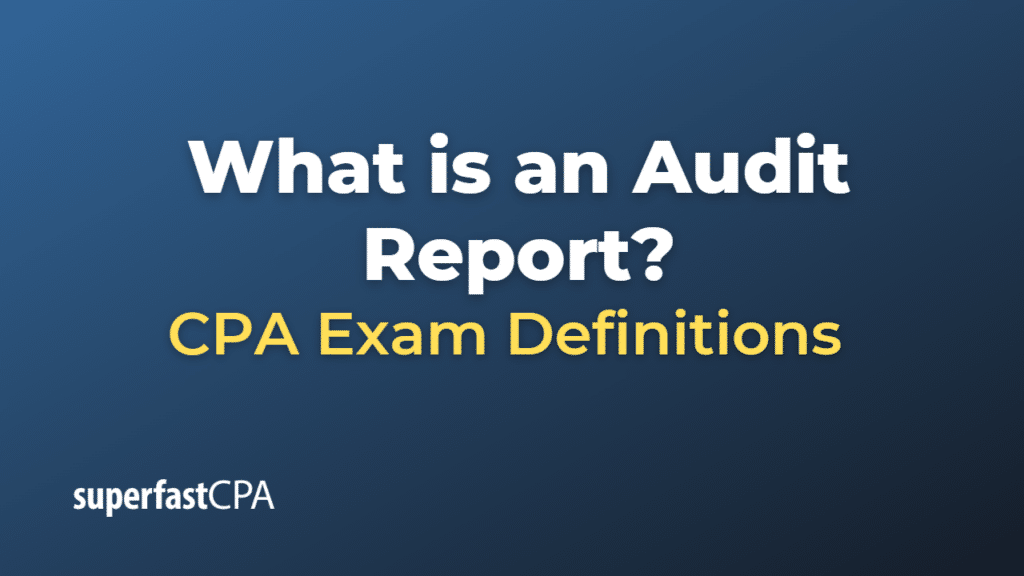Audit Report
An audit report is a formal document prepared by an independent auditor after completing an examination of an organization’s financial statements. The purpose of the audit report is to provide an opinion on the fairness and accuracy of the financial statements and whether they have been prepared in accordance with the applicable financial reporting framework, such as Generally Accepted Accounting Principles (GAAP) or International Financial Reporting Standards (IFRS).
An audit report typically includes the following sections:
- Title: The title indicates that it is an independent auditor’s report.
- Addressee: The report is usually addressed to the shareholders or the board of directors of the company being audited.
- Introductory Paragraph: This paragraph briefly explains the scope of the audit and identifies the financial statements that were audited.
- Management’s Responsibility: This section highlights that the management of the company is responsible for preparing and presenting the financial statements, as well as maintaining effective internal controls.
- Auditor’s Responsibility: This section describes the auditor’s responsibility to express an opinion on the financial statements based on their audit, conducted in accordance with applicable auditing standards.
- Opinion: The opinion is the most critical part of the audit report, where the auditor states whether the financial statements present a fair and accurate view of the company’s financial position and performance. There are four types of audit opinions:
- Unqualified Opinion (Clean Opinion): The financial statements are presented fairly and in accordance with the applicable financial reporting framework.
- Qualified Opinion: The financial statements are mostly presented fairly, but there are specific issues or deviations from the applicable financial reporting framework.
- Adverse Opinion: The financial statements do not present a fair and accurate view of the company’s financial position and performance due to significant misstatements or non-compliance with the applicable financial reporting framework.
- Disclaimer of Opinion: The auditor is unable to express an opinion on the financial statements due to a lack of sufficient appropriate audit evidence or significant uncertainties.
- Signature and Date: The report is signed by the auditor or the audit firm and includes the date of the report.
- Auditor’s Address: The address of the auditor or the audit firm is mentioned at the end of the report.
The audit report is an essential tool for shareholders, investors, regulators, and other stakeholders to assess the financial health and performance of a company, and to make informed decisions based on the financial information provided.
Example of an Audit Report
Here’s an example of a simplified audit report with an unqualified opinion:
INDEPENDENT AUDITOR’S REPORT
To the Shareholders of XYZ Company
We have audited the accompanying financial statements of XYZ Company, which comprise the balance sheet as at December 31, 20XX, and the income statement, statement of changes in equity, and cash flow statement for the year then ended, and a summary of significant accounting policies and other explanatory notes.
Management’s Responsibility for the Financial Statements Management is responsible for the preparation and fair presentation of these financial statements in accordance with International Financial Reporting Standards (IFRS); this includes the design, implementation, and maintenance of internal control relevant to the preparation and fair presentation of financial statements that are free from material misstatement, whether due to fraud or error.
Auditor’s Responsibility Our responsibility is to express an opinion on these financial statements based on our audit. We conducted our audit in accordance with International Standards on Auditing (ISA). Those standards require that we comply with ethical requirements and plan and perform the audit to obtain reasonable assurance about whether the financial statements are free from material misstatement.
An audit involves performing procedures to obtain audit evidence about the amounts and disclosures in the financial statements. The procedures selected depend on the auditor’s judgment, including the assessment of the risks of material misstatement of the financial statements, whether due to fraud or error. In making those risk assessments, the auditor considers internal control relevant to the entity’s preparation and fair presentation of the financial statements to design audit procedures that are appropriate in the circumstances, but not for the purpose of expressing an opinion on the effectiveness of the entity’s internal control. An audit also includes evaluating the appropriateness of accounting policies used and the reasonableness of accounting estimates made by management, as well as evaluating the overall presentation of the financial statements.
Opinion In our opinion, the financial statements present fairly, in all material respects, the financial position of XYZ Company as at December 31, 20XX, and its financial performance and its cash flows for the year then ended in accordance with International Financial Reporting Standards (IFRS).
[Signature of the Audit Firm]
[Date of the Audit Report]
[Auditor’s Address]
Please note that this is a simplified and generalized example. A real audit report may contain more details and specific information about the company being audited.













